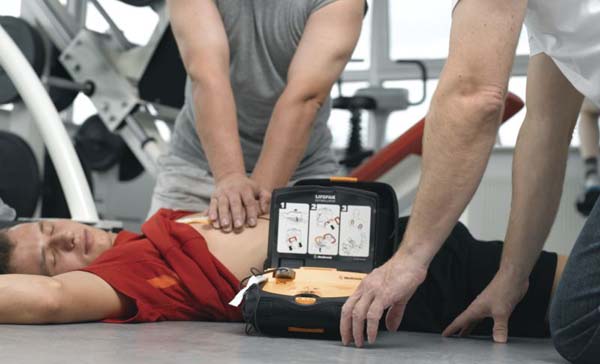
AED with rain and wet: guideline to the use in particular environment
Generally, AED can be used without any risk. But, are we sure that it is safe, no matter the environment? Enrico Baldi, doctor at Fondazione IRCCS Policlinico San Matteo – Pavia and qualified in Cardiology wrote an article about the argument published by the Official Journal of the European Resuscitation Council.
In the majority of situations itis easy to determine if it is possible to use an AED without any risk. Anyway, every CPR/AED instructor knows that a layperson might be in doubt if the AED can be used with safety in particular situations.
AED in particular environment: an interesting review
Since we started our activity in spreading CPR/AED knowledge, we heard an extreme variability of answers from instructors of different training centres when an attendee asks how to use an AED in situations that concern snow, rain, wet floor and more.
In order to help instructors during their courses, we performed a brief revision of literature about AED safety in particular environments. If a person is lying on snow or ice it is safe to use an AED as both are not good conductors. It is safe also if a person lying on metal surfaces because they pose no shock hazard to either victim or rescuer.
The most difficult situations to interpret are that in which water is present on the scene. In literature, there are different recommendations and evidence about this aspect, so it could be particularly difficult for instructors to suggest to lay people a simple and unique way to act.
AHA 2010 Guidelines
AHA 2010 Guidelines recommend that it may be reasonable to remove the victim from the water before attaching electrode pads and attempting defibrillation (Class IIb, LOE C), whilst UK Resuscitation Council advise that it is safe to use an AED on a victim who is lying on a wet surface and ERC Guidelines don’t address this point.
Moreover, AED manufactures, Zoll and Philips, experimented the use of their devices on water, concluding that the current that can reach the rescuer is not enough to cause any hazard (3V where was the simulated rescuer and 12V under the simulated patient).
In addition, it is reasonable to assume that a rainy environment should present no additional risks to the operators since the conductivity of rainwater is less than pool water.
In literature there is an independent study, carried out by Lyster T. et al., which demonstrated, using raw turkeys lying on pool water and on saltwater, that the maximum current that reached the simulated operator at 15 cm from the simulated patients was 30V, lower than allowed by safety standards and unlikely to be hazardous.
AED in a particular environment: evidences
Summarizing, nowadays there is evidence that using AED in a wet environment (such as a pitch after rain, a puddle or a wet floor) is safe and that there is no hazard for the patient if safety procedure is performed (self-adhesive pads are applied correctly, no direct contact between the user and the victim and no water between the pads).
In respect of that, we think that it is reasonable to suggest to laypersons to remove the victim from water if it can be done in less than 10 seconds but to use anyway the AED if the patient cannot be moved. Likewise, in a rainy environment, the rescuers can use the AED unless the rain is heavy enough to not afford to keep chest dried.
However, we hope that there may be further evidence in the near future that can reinforce those already presenting literature and that there will be in next Guidelines a clear and unambiguous indication for lay rescuers on this issue.


